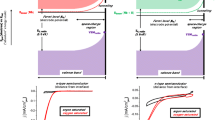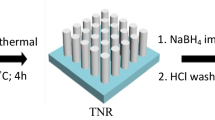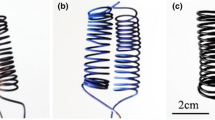Abstract
An indium tin oxide (ITO) electrode coated with monolayer TiO2/[Ru(phen)2(dC18bpy)]2+ (phen = 1,10-phenanthroline, dC18bpy = 4,4′-dioctadecyl-2,2′-bipyridyl) hybrid film (denoted as ITO/TiO2-Ru) has been prepared using the modified Langmuir-Blodgett (LB) method, and the electrocatalytic oxidation of mononucleotide of guanosine 5′-monophosphate (GMP) on an ITO/TiO2-Ru electrode after Pd-photodeposition (denoted as ITO/TiO2-Ru/Pd) has been studied. Atomic force microscopy reveals that the single-layered hybrid film of TiO2 nanosheets/[Ru(phen)2(dC18bpy)]2+ is closely packed at a surface pressure of 25 mN m−1 and has a thickness of (3.20 ± 0.5) nm. X-ray photoelectron spectra show the formation of Pd nanoparticles on the surface of hybrid film with radii of 20–200 nm by the reduction of [Pd(NH3)4]2+ under light irradiation. When it is applied to oxidize GMP, a larger catalytic oxidative current is achieved on the ITO/TiO2-Ru/Pd electrode at the external potential above 700 mV (vs. Ag|AgCl|KCl) in comparison with the naked ITO electrode and ITO/TiO2-Ru electrode. Such a result indicates that the Pd nanoparticles are able to hamper the combination of electron hole pairs and reduce the counterwork of insulating long alkyl chains of amphiphilic Ru(II) complexes, and thus develops the electron transfer efficiency and produces the enhanced redox current.
Similar content being viewed by others
References
Janos HF. Nanoparticle, Nanostructured Films. New York: Weinheim
Bard AJ, Faulkner LR. Electrochemical Method: Fundamentals and Applications. 2nd ed. New York: John Wiley & Sons, 2001
Kleinfeld ER, Ferguson GS. Stepwise formation of multilayered nanostructural films from macromolecular precursors. Science, 1994, 265: 370–373
Taguchi Y, Kimura R, Azumi R, Tachibana H, Koshizaki N, Shimomura M, Momozawa N, Sakai H, Abe M, Matsumoto M. Fabrication of hybrid layered films of MoS2 and an amphiphilic ammonium cation using the Langmuir-Blodgett technique. Langmuir, 1998, 14: 6550–6555
Kuzmenko I, Rapaport H, Kjaer K, Als-Nielsen J, Weissbuch I, Lahav M, Leiserowitz L. Design and characterization of crystalline thin film architectures at the air-liquid interface: simplicity to complexity. Chem Rev, 2001, 101: 1659–1696
He JX, Kobayashi K, Takahashi M, Villemure G, Yamagishi A. Preparation of hybrid films of an anionic Ru(II) cyanide polypyridyl complex with layered double hydroxides by the Langmuir-Blodgett method and their use as electrode modifiers. Thin Solid Films, 2001, 397: 255–265
He JX, Yamagishi A, Iwao M, Abe Y, Umemura Y. Creation of a novel solid surface as a model photosynthetic system. II. Application of the LB and self-assembly methods to a fixation of a light-driven polypyridyl Ru(II) complex. Electrochem Comm, 2004, 6: 61–65
He JX, Sato H, Umemura Y, Yamagishi A. Sensing of molecular chirality on an electrode modified with a clay-metal complex hybrid film. J Phys Chem B, 2005, 109: 4679–4683
Zhou HH, Ning XH, Li SL, Chen JH, Kuang YF. Synthesis of polyaniline-silver nanocomposite film by unsymmetrical square wave current method. Thin Solid Films, 2006, 510: 164–168
Aoki PHB, Volpati D, Riul JA, Caetano W, Constantino CJL. Layer-by-layer technique as a new approach to produce nanostructured films containing phospholipids as transducers in sensing applications. Langmuir, 2009, 25: 2331–2338
Gosh PK, Bard AJ. Clay-modified electrodes. J Am Chem Soc, 1983, 105: 5691–5693
Navrátilová Z, Kula P. Clay modified electrodes: present applications and prospects. Electroanalysis, 2003, 15: 837–846
Song C, Villemure G. Preparation of clay-modified electrodes by electrophoretic deposition of clay films. J Electroanal Chem, 1999, 462: 143–149
Ulman A. An Introduction to Ultrathin Organic Films. San Diego: Acadmic Press, 1991
Petty MC. Langmuir-Blodggett Films. Cambridge: Cambridge University, 1996
Roubeau O, Natividad E, Agricole B, Ravaine S. Formation, structure, and morphology of triazole-based Langmuir-Blodgett films. Langmuir, 2007, 23: 3110–3117
Qaqish SE, Matthew FP. Mechanistic Insight into domain formation and growth in a phase-separated Langmuir-Blodgett monolayer. Langmuir, 2007, 23: 10088–10094
Laura J, Cote FK, Huang JX. Langmuir-blodgett assembly of graphite oxide single layers. J Am Chem Soc, 2009, 131: 1043–1049
Chang XQ, Wang S, Lin DJ, Guan WP, Zhou H, Huang SM. Photoelectrocatalytic oxidation of GMP on an ITO electrode modified with clay/[Ru(phen)2(dC18bpy)]2+ hybrid film. Sci China Ser B-Chem, 2009, 52: 318–324
Yoshida J, Saruwatari K, Kameda J, Sato H, Yamagishi A, Sun L, Corriea M, Villemure G. Electron transfer through clay monolayer films fabricated by the Langmuir-Bloddgett technique. Langmuir, 2006, 22: 9591–9597
Sasaki T, Watanabe M, Hashizume H, Yamada H, Nakazawa H. Macromolecule-like aspects for a colloidal suspension of an exfoliated titanate. Pairwise association of nanosheets and dynamic reassembling process initiated from it. J Am Chem Soc, 1996, 118: 8329
Sasaki T, Watanabe M. Semiconductor nanosheet crystallites of quasi-TiO2 and their optical properties. J Phys Chem B, 1997, 101: 10159–10161
He JX, Yang P, Sato H, Umemura Y, Yamagishi A. Effects of Ag-photodeposition on photocurrent of an ITO electrode modified by a hybrid film of TiO2 nanosheets. J Electroanal Chem, 2004, 566: 227–233
Zhou H, Wang S, Lin JJ, Chen XA, Cai XQ, Wen HH, Jiang F. Enhanced photocurrent of an ITO electrode by the photoposition of Pt nanoclusters onto a monolayer TiO2-Ru complex hybrid film (in chinese). Acta Chimica Sinica, 2010, 68: 367–373
Jung CH, Sánchez-Sánchez CM, Lin CL, Rodríguez-Lopez J, Bard AJ. Electrocatalytic activity of Pd-Co bimetallic mixtures for formic acid oxidation studied by scanning electrochemical microscopy. Anal Chem, 2009, 81: 7003–7008
Chu DB, Wang J, Wang SX, Zha LW, He JG, Hou YY, Lin HS, Tian ZW. High activity of Pd-In2O3/CNTs electrocatalyst for electro-oxidation of ethanol. Catal Commun, 2009, 10: 955–958
Lee H, Habas SE, Somorjai GA, Yang PD. Localized Pd overgrowth on cubic Pt nanocrystals for enhanced electrocatalytic oxidation of formic acid. J Am Chem Soc, 2008, 130: 5406–5407
Steidtner J, Hernandez F, Baltruschat H. Electrocatalytic reactivity of Pd monolayers and monatomic chains on Au. J Phys Chem C, 2007, 111: 12320–12327
Tamura K, Setsuda H, Taniguchi M, Yamagishi A. Application of the Langmuir-Blodgett technique to prepare a clay-metal complex hybrid film. Langmuir, 1999, 15: 6915–6920
Kapoor S. Preparation, characterization, and surface modification of silver particles. Langmuir, 1998, 14: 1021–1025
He JX, Sato H, Umemura Y, Yamagishi A. Sensing of molecular charality on an electrode modified with a clay-metal complex hybrid film. J Phys Chem B, 2005, 109: 4679–4683
Tura JM, Regull P, Victori L, Castellar MD. XPS and IR (ATR) analysis of Pd oxide films obtained by electrochemical methods. Surf Interface Anal, 1988, 11: 447–449
Tressaud A, Khairoun S, Touhara H, Watanabe N. X-ray photoelectron spectroscopy of palladium fluorides. Z Anorg Allg Chem, 1986, 540: 291–299
Shepherd RE, Proctor A, Henderson WW, Myser TK. Assessment of the π-acceptor capability of selected ligands based on the photoelectron spectra of ruthenium ammine complexes. Inorg Chem, 1987, 26: 2440–2444
Khan MMT, Srivastava S. Some new ruthenium(III) schiff base complexes: A photoelectron spectroscopic study. Polyhedron, 1988, 7: 1063–1065
Aarnik WAM, Weishaupt A, Silfout VA. Angle-resolved X-ray photoelectron spectroscopy (ARXPS) and a modified Levenberg-Marquardt fit procedure: a new combination for modeling thin layers. Appl Surf Sci, 1990, 45: 37–48
Taylor JA, Lancaster GM, Ignatiev A, Rabalais JW. Interactions of ion beams with surfaces. Reactions of nitrogen with silicon and its oxides. J Chem Phys, 1978, 68: 1776–1785
Cahen D, Ireland PJ, Kazmerski LL, Thiel FA. X-ray photoelectron and Auger electron spectroscopic analysis of surface treatments and electrochemical decomposition of CuInSe2 photoelectrodes. J Appl Phys, 1985, 57: 4761–4771
Krause MO, Haire RG, Keski-Rahkonen O, Peterson JR. Photoelectron spectrometry of the actinides from Ac to Es. J Electron Spectrosc Relat Phenom, 1988, 47: 215–226
Nyholm R, Martensson N. Core level binding energies for the elements Zr-Te. J Phys C: Solid State Phys, 1980, 13, L279–L284
Dennis AM, Howard RA, Kadish KM, Bean JL, Brace J, Winograd N. X-ray photoelectron spectra of some dirhodium carboxylate complexes. Inorg Chim Acta, 1980, 44: L139–L141
Staniewicz RJ, Sympson RF, Hendricker DG. Preparation and investigation of the spectral and electrochemical properties of mixed-ligand ruthenium(II) complexes containing 1,8-naphthyridines. Inorg Chem, 1977, 16: 2166–2171
Kim BH, Lee DN, Park HJ, Min JH, Jun YM, Park SJ, Lee WY. Synthesis and characterization of electrochemiluminescent ruthenium( II) complexes containing o-phenanthroline and various α-diimine ligands. Talanta, 2004, 62: 595–602
Yuan XX, Xu NX. Determination of hydrogen diffusion coefficient in metal hydride electrode by cyclic voltammetry. J Alloys Compd, 2001, 316: 113–117
He JX, Kobayashi K, Chen YM, Villemure G, Yamagishi A. Electrocatalytic response of GMP on an ITO electrode modified with a hybrid film of Ni(II)-Al(III) layered double hydroxide and amphiphilic Ru(II) cyanide complex. Electrochem Comm, 2001, 3: 473–477
Author information
Authors and Affiliations
Corresponding author
Rights and permissions
About this article
Cite this article
Chen, X., Wang, S., Lin, J. et al. Electrocatalytic oxidation of GMP on an ITO electrode modified by the photodeposition of Pd nanoparticles onto a monolayer TiO2 nanosheets/[Ru(phen)2(dC18bpy)]2+ hybrid film. Sci. China Chem. 54, 483–489 (2011). https://doi.org/10.1007/s11426-010-4190-x
Received:
Accepted:
Published:
Issue Date:
DOI: https://doi.org/10.1007/s11426-010-4190-x




